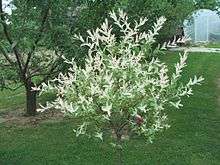Salix integra
Salix integra (Chinese: 杞柳 qi liu; Japanese: イヌコリヤナギ inukoriyanagi ; syn. S. multinervis Franch. & Savatier) is a species of willow native to northeastern China, Japan, Korea and Primorsky Krai in the far southeast of Russia.[1][2]
| Salix integra | |
|---|---|
 | |
| Scientific classification | |
| Kingdom: | Plantae |
| Clade: | Tracheophytes |
| Clade: | Angiosperms |
| Clade: | Eudicots |
| Clade: | Rosids |
| Order: | Malpighiales |
| Family: | Salicaceae |
| Genus: | Salix |
| Species: | S. integra |
| Binomial name | |
| Salix integra | |
It is a deciduous shrub growing to 2–6 m tall with greyish-green bark and reddish to yellowish shoots. The leaves are 2–10 cm long and 1–2 cm wide; they are pale green both above and below, and unusually for a willow, are often arranged in opposite pairs or whorls of three, rather than alternate. The flowers are produced in small catkins 1-2.5 cm long in early spring; they are brownish to reddish in colour. It is dioecious, with male and female catkins on separate plants.[1][3]
It is closely related to the European and western Asian Salix purpurea, and has been treated as a variety of it by some authors, as S. purpurea var. multinervis (Franchet & Savatier) Matsumura, or as a subspecies S. purpurea subsp. amplexicaulis (Chaubard) C.K.Schneid.[1][3]
Cultivation and uses

The cultivar 'Hakuro Nishiki' (dappled willow) is widely grown as an ornamental plant for its variegated foliage, the leaves strongly mottled with patches and blotches of white and pale pink. As its growth is fairly weak and shrubby, it is commonly sold grafted on the top of a straight stem of another willow. It has gained the Royal Horticultural Society’s Award of Garden Merit.[4][5]
References
| Wikimedia Commons has media related to Salix integra. |
- Flora of China: Salix integra
- "Salix integra". Germplasm Resources Information Network (GRIN). Agricultural Research Service (ARS), United States Department of Agriculture (USDA). Retrieved 23 January 2018.
- Japanese Treeflowers: Salix integra
- "RHS Plantfinder - Salix integra 'Hakuro-Nishiki'". Retrieved 11 October 2018.
- "AGM Plants - Ornamental" (PDF). Royal Horticultural Society. July 2017. p. 93. Retrieved 11 October 2018.